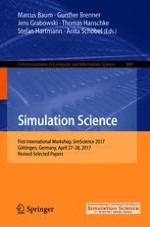2018 | Book
Simulation Science
First International Workshop, SimScience 2017, Göttingen, Germany, April 27–28, 2017, Revised Selected Papers
Editors: Prof. Dr. Marcus Baum, Prof. Dr. Gunther Brenner, Prof. Dr. Jens Grabowski, Thomas Hanschke, Prof. Dr. Stefan Hartmann, Anita Schöbel
Publisher: Springer International Publishing
Book Series : Communications in Computer and Information Science
